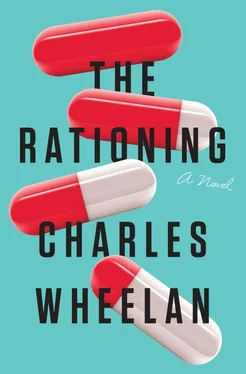“How does it spread?” the President demanded. We were sitting on sofas. He was at his desk, signing documents of some sort. I noticed for the first time that he was left-handed. No one answered. “How does it spread?” the President repeated impatiently, looking up from the papers he was signing, as if to say that we were wasting some of the precious fifteen minutes we had been allotted. The other participants on the couches looked at me.
“It doesn’t spread, actually,” I said. “That’s what’s so curious. The virus is very common. Most of us are probably carrying it now. It’s just that for some people, under some circumstances, it turns lethal.”
“Which people and under what circumstances?” the President asked.
“We don’t understand that yet,” I said.
“Jesus, what the hell else is there to understand?” the President said, tossing his pen onto the desk. “That’s pretty much all that matters.”
“We have a team of people working on this around the clock,” the Director of the NIH interjected.
“How quickly is it spreading?” the President asked.
“We don’t like to use the word ‘spread,’” I answered. I did not feel comfortable correcting the President of the United States, but this was a crucial point. I continued, “It implies that there is some kind of contagion, that people catch it from one another. That’s not really how this thing works. You have it or you don’t. And it turns deadly or it doesn’t. It’s more like cancer than the measles.”
“But it’s a virus?” the President asked.
I answered, “Yes, it’s a virus, but—”
“People are not going to understand that,” the President’s Strategist interrupted. “No fucking way. There is no way we can explain to the public that there is a virus killing people but that it’s not contagious.”
“I just explained it,” I said.
The Strategist laughed dismissively. “Twenty percent of the country does not understand that the earth rotates around the sun. This is going to be fucking mayhem.”
“It seems to me that we need to stockpile more Dormigen,” the President directed. “And we need to figure out what the hell is going on with this a cappella virus.”
“ Capellaviridae ,” I said. The President did not dignify my correction.
The Director of the NIH said, “We’ve reached out to all the OECD countries to borrow enough Dormigen to cover our gap until our stocks are replenished. But, frankly, we’re getting a little pushback because most of these countries are either seeing the same increase in Capellaviridae -related illness, or they’re afraid they will soon. They’re hesitant to make a firm commitment.”
“So what’s the number?” the Strategist asked of no one in particular.
“What number?” the Chief of Staff replied.
“How many people will die?” he asked.
“It’s not that simple,” I offered.
“Yes, it is,” he said. “We have some estimate of the rate at which this virus turns fatal, right?”
“A guess,” I said. “It’s pretty rough.”
“Well, it’s going to get less rough as we get more data,” the Strategist said, indignant that this had to be explained. “For now, we have an estimate?” he asked. I nodded yes. He continued, “Okay, based on that estimate, we can project what the demand for Dormigen is likely to be and when our stocks will run out, if they will.” He looked around the room. “Am I not speaking English here?”
“These are all very inaccurate projections,” the Director of the NIH said, visibly annoyed by the Strategist’s reductionist logic.
“For fuck sake, people, an inaccurate projection is better than nothing. We need to know what might happen here, even if it’s just our best guess.”
“He’s right,” the President said. “We need to put some numbers against this. What kind of problem are we talking about?”
“There are a lot of variables,” the Director of the NIH explained. “What is the rate at which the virus turns fatal, how much Dormigen will we need for other health issues around the country, how much Dormigen can we borrow—”
“Obviously,” the Strategist interrupted. “So we build a model with our best estimate for each of those variables. Then we update the model as our information gets better.” He looked around the room as if he were teaching fractions to fourth-graders. “Yes?”
“That’s exactly what we do,” the Secretary of Defense agreed. “We’ll never have all the information we need, but there is no excuse for not making a plan with the best information we have at any given moment.”
“Thank you,” the Strategist said. He was not being sarcastic or deliberately mean. He simply felt relieved when others finally caught up. “That model is going to spit out one number that counts: How many people die from this sleeping virus, or whatever the fuck it is, because we run out of Dormigen? That’s it, one number, that’s what matters here—like I said five minutes ago.”
“Right now that number is zero,” the NIH Director said, trying to reassure the room. “We have likely commitments from enough OECD nations that we should be able to cover the Dormigen deficit.”
“What exactly is a ‘likely commitment’?” the President asked.
“Sounds to me like a military treaty with the French,” the Secretary of Defense offered.
“We’re still working that out,” the Chief of Staff said. “The disruption at HHS has made things more difficult.”
“That’s why we need somebody from HHS in this group,” the President repeated.
The Secretary of Defense offered, “In my experience, commitments become wobbly when the shooting starts. I think the relevant number here is how much Dormigen we have in our possession, not what’s been promised.”
“I agree,” the President said.
The Chief of Staff nodded, making notes on a legal pad in an elegant leather case with the White House logo on it. Yes, I was sitting in the Oval Office, but the meeting felt like every other meandering group discussion I had been a part of—until this point. “Okay, then,” the Chief of Staff said, “I will brief the Acting Secretary at HHS. We need to firm up the Dormigen commitments from OECD allies. The Capellaviridae task force needs to speed up their work and get us an estimate on the rate at which this thing is spreading—or whatever we want to call it. We’ll use that to build the model we discussed.” As she ticked off each item, she pointed her Montblanc pen at the person responsible, who would nod in acknowledgment. “Anything else?”
Silence. “Okay, then let’s meet again tomorrow,” she said.
“I don’t need to be in the room for that,” the President said.
“Let’s see what we learn,” the Chief of Staff replied. With that, she stood up and we followed her out. The President did not look up as we left. From that point on, we were talking about “the number.”
THE PRESIDENT WAS TALL AND THIN, HANDSOME IN A POLITICAL kind of way. He had good hair. He kept it long to emphasize that, I suspect. He had been a high school basketball star in Virginia, where he still holds the high school record for most points in a single season. His team did not win the championship that year, as many commentators have pointed out. “He’s the kind of guy who yells at you if you don’t make a shot,” one of his teammates said years later. (In my limited experience, that is exactly what makes mediocre players clutch up and shoot worse.) In any event, the President was smart, refined, and politically savvy. He may not have had the natural political talent of the Majority Leader, but he made few mistakes. Every decision was put through a fine political filter, beginning in his early twenties. He was accepted to Yale Law School but attended the University of Virginia instead. I spent enough time pretending that I was going to law school to know that Yale is a better law school—arguably the best—but the University of Virginia is a better place from which to launch a political career in Virginia.
Читать дальше












